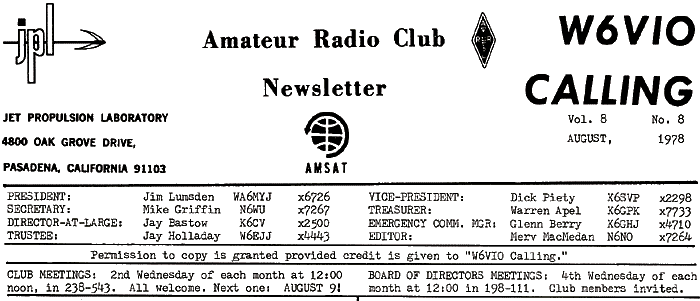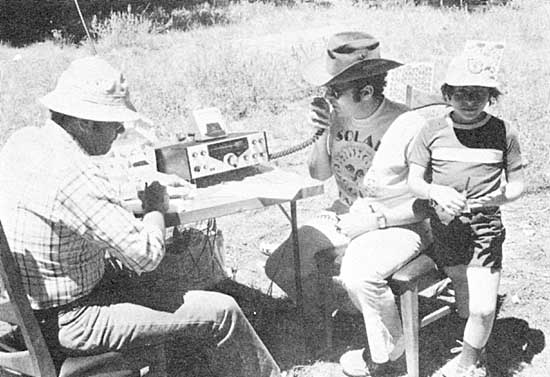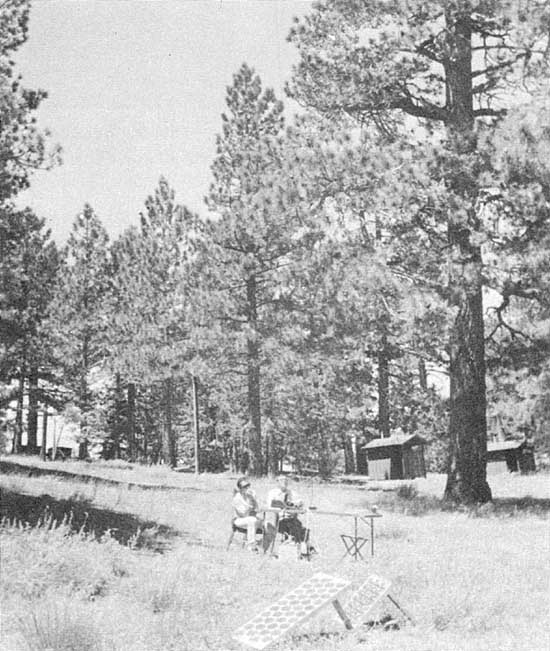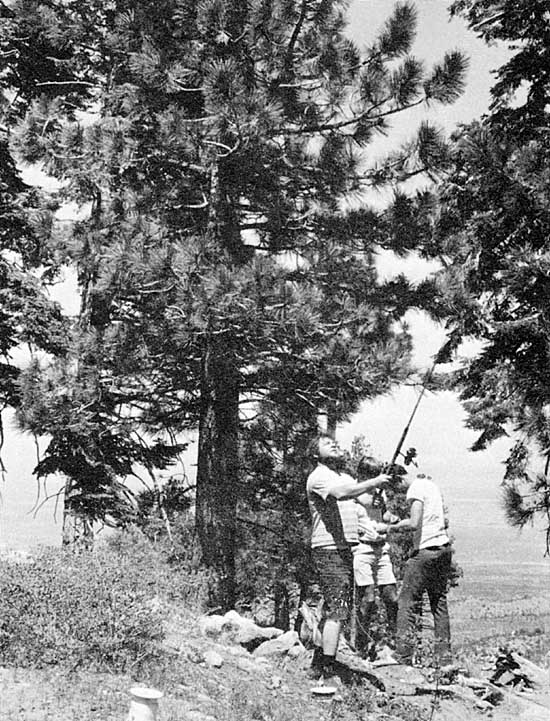
AUGUST 9th MEETING: RADON MONITORING NETWORK
Our guest speaker on August 9th will be Dr. Mark H. Shapiro, K6OGD, who will describe the Caltech automated Radon monitoring network as developed for sensing seismic activity. Together with Dr. Jon Melvin of the Kellogg Radiation Laboratory, he has been involved in the development of these low cost, fully automated units for the past two years. The instruments are now being remotely sited as part of the earthquake prediction research program in California. Dr. Shapiro is an associate professor of physics at Cal State Fullerton and a visiting associate at Caltech. He also is vice-president of the Fullerton Radio Club. (Tnx W6HCD)
FIELD DAY REPORT by Mike Griffin, N6WU
Field Day weekend (24-25 June) is over for this year and as the expression goes, we have some good news and some bad news. The good news is that W6VIO/6 participated with a minimum of technical problems in erecting antennas, getting rigs up and running, etc. The bad news is that we just didn't have enough member participation to put on a good effort. Eleven members and one guest turned out, and that was just not enough to keep us on the air for the full 24 hours with the planned three transmitters. In fact, it wasn't enough to keep even one station up for the full period. It's just a fact of life that the same guys who show up at 7:00 A.M. to begin putting up antennas, setting up stations, cooking, etc., simply cannot stay awake at 4:00 A.M. the next morning! Especially not when the work is being done at 7000-feet of elevation.
Rich Ward, N6BF, his guest Dean, WA6VWR, and myself held down most of the CW work with Rich's FT-101B and a tribander. This position produced 381 QSOs for 762 points in 15 hours on the air. Dean produced one of the funniest sights of the weekend when he was kicked out of bed around six in the morning by Rich and myself. Barely conscious, he cranked the keyer speed up to about twice what Rich and I were running and proceeded to pick up where he left off the night before. Now there is a CW man.

Rich Ward, N6BF, and Dean Ryan, WA6VWR, holding down 20 meter CW. (All photos by K6PGX.)
Two HF phone stations were set up, one using the Triton IV transceiver of Gil Yanow, K6TOS, and the other the club's FT-101E. These rigs turned out to be quite effective (or was it ops?), producing 537 phone QSOs in 24 hours on the air. The Triton was a particular pleasure to operate, as the solid state finals kept the power drain down and allowed instant QSY. A solar panel brought by Gil furnished more than enough power to run the rig and keep up the charge on a storage battery at the same time. Operators who kept the phone stations running were K6SVP, K6TOS, WA6MYJ, WB6EMO, N6QV, WA6LWD, and WB6DRH. Wes, W6PVR, visited and lent moral support.
VHF was not really productive. An hour and a half of operation by K6PGX and WB6EM0 produced, at different times, 24 QSOS, but in general it seemed easy to work through the available stations pretty quickly.

Gil Yanow, K6TOS, and Dick Piety, K6SVP, run the solar-powered phone station with assistance from Kenneth Yanow.
Food preparation, which had loomed as the biggest problem prior to FD, was handled sumptuously by Gordon Crawford, WB6DRH, and his wife Virginia and daughter Sherry. The whole family really pitched in and did a job, providing spaghetti and salad for Saturday night, with pancakes, bacon, eggs, and coffee for Sunday morning. Lots more munchies were available to those who wanted them. The Crawfords really deserve a vote of thanks for taking on this arduous task.
As for antennas, our dipoles performed as expected, which was well, and a "long wire" (really only 500 feet) worked well on 40 meters, but the real story was the success we had with the two tribanders. Following an idea from Jim Lumsden, these were hoisted high into two clearings with nylon ropes running over appropriately-positioned trees. A surf-casting rod was used to get them into position.

The solar-powered rig and a tribander 30 feet in the air, supported by nylon line over nearby trees.
The whole setup worked beautifully, and the rigs using the beams were in general able to QSO about as fast as they could log. Limited steering was possible with a little rope work, but really wasn't necessary, as plenty of stations could be worked by just pointing them east and relying on the west coast location and the 7000 foot altitude for help.
The final tally for our efforts shows 942 QSOs, 1323 points for a score (with power multiplier) of 2646, prior to addition of 100 points for 100% use of emergency power.

Ron Reasoner, N6QV, illustrates the approach to getting the lines up, while WA6MYJ and N6WU try to sort out the mess.
As for next year, there seem to be several things to work on. One is clearly a site more amenable to attracting members. If you have any thoughts on this, send them my way. It would also seem necessary to either get a group of members to agree well in advance to handle food preparation, or to simply let each person fend for himself. While a club dinner is nice, and certainly something we can afford, it is just not fair to have one or two people shouldering the burden themselves. Gordon, for example, had hardly any time to operate. It's probably also fair to say that one requirement for next year is a little better organization from your author!
FIVE STAR SALUTE
While Jim, WA6MYJ, may complain that our members don't volunteer enough, here's a case where the membership really came through when the chips were down. You may not have noticed it, because in his modesty he neglected to mention it, but in your editor's absence on Seasat matters last month, the entire July issue was put out by Steve Brown, N6OE. Excellent job, Steve, Tnx! (N6NO)
ARRL BOARD MEETING HIGHLIGHTS (Official Bulletin 718 from ARRL Headquarters, July 22, 1978)
Reports on the ongoing preparation for the 1979 World Administrative Radio Conference highlighted the second 1978 meeting of the ARRL Board of Directors held in Hartford, CT, on July 20 and 21. The Board once again addressed the question of League representation in Washington, DC, by accepting a report from the president and general manager, which included a proposed position description for a resident Washington representative. The position description instead was adopted as a task assignment list for the present Washington coordinator. In FCC matters, the president was instructed to take all possible steps to defend presently held club call signs, including judicial review of FCC actions if required. Notice of appeal of the FCC ban on ten-meter amplifiers will be filed if study indicates there is a reasonable chance of success. Early FCC action to permit conventional fm at 52 to 52.5 MHz was urged. The League will petition for all-mode privileges for Novice licensees in the 220 MHz band. In operating matters, the ARRL DX Competition was reduced to one weekend per mode effective in 1979. Additional criteria for contest disqualifications were adopted. Efforts to promote increased Amateur Radio Emergency Service activity were ordered. Board concern was expressed over operating tactics harmful to the image of amateur radio, especially during rare DXpeditions. The Public Service award was replaced with new categories of commendations to provide greater recognition for outstanding performance. Studies were directed of awards for mobile operation and to encourage activity above 220 MHz. In organizational matters, the dues rate for life membership was raised to 25 times the annual rate, effective November 1, 1978. The general manager was authorized to employ professional consultants to seek grants for the funding of League programs. Preparation of a question-and-answer type of supplement to the License Manual was directed. Guidelines were adopted for financial assistance by the League in local legal cases, which might establish or upset precedents important to the amateur community. A contest to establish a design for an official ARRL flag was ordered. Publications of comparisons between claimed specifications and ARRL laboratory measurements on manufactured equipment in QST "Product Review" was directed. Complete minutes of the meeting will appear in September QST. (Tnx W6EJJ)
NOVICES ON 220 - SHOULD WE OR SHOULDN'T WE? (de W6EJJ)
One proposal that was introduced at the recent ARRL Board meeting deserves careful consideration. Simply stated, it is: "Should novice-class licensees be allowed all-mode privileges on 220 MHz?"
The rationale in favor of this idea was presented as follows: With the opening of an additional 1 MHz of two meters for repeaters, the pressure to put new repeaters on 220 MHz has all but disappeared in most of the U.S. In addition, the threat to 220 MHz by a Class E CB band has not disappeared; it is still a viable option according to a recent FCC study. In order to encourage increased 220 MHz activity around the country, ARRL President Harry Dannals advocates opening up the band to permit use of all modes by novice-class licensees.
Based on the League's earlier advocacy of limited phone privileges or. 144 and 220 MHz, together with its endorsement of a modified version of the Communicator Class license, the Board voted to support the idea of all mode privileges on 220 for novices.
Since my return from the Board meeting, I have discussed this issue with a number of amateurs in the Southwestern Division and have gotten mixed reactions. Good points have been made both for and against the proposal. It does appear that there should at least be some restrictions placed on the proposed novice operation, e.g., it should be restricted to a sub band of 220 MHz to minimize interference to auxiliary link and remote control operations.
I would welcome comments from anyone who is interested in this subject -either in favor or opposed. In particular, if the League does file in favor of this, what restrictions should be placed on novice operations on 220; or, what incentives to upgrade should be included? Brief, handwritten responses would be most welcome and would help make a better case to the League management. (Ed. note: Jay Holladay, the writer of this plea, may be reached at JPL ext. 4443 or mail address 233-208; or at 5128 Jessen Dr., La Canada, CA 91011.)
WR6APS Conducted by Booth Hartley, N6BH
The JPLARC Repeater Committee has chosen a club simplex frequency to offload the repeaters when users are within simplex range, and when out of repeater range (e.g., JPL picnic, Baja races, etc.) See Ron Ploszaj, WA6TPW (x4429) for your crystals.
WR6APR, our other repeater which we hope will soon have autopatch capability, is now back in service with the receiver that bailed out WR6APS a month ago. Use of WR6APR (222.48 in/224.08 out) by club members is encouraged; however, there is still a minor problem with the audio level control in the compressor.
Don't forget the new schedule for the OSCAR net on WR6APS: Wednesday evenings, instead of Tuesdays, at 8pm local time. The regular JPLARC amateur radio news net continues on Monday nights at 8pm. Both nets are linked to WR6AZN (Table Mountain) on 222.36/223.96.
Those of you that follow the 2-meter scene should note that the 2-meter Table Mountain Repeater (also WR6AZN) is changing frequency from 93/33 to 144.68 in/145.28 out effective about the first of August. The 93/33 coordination was only temporary, on a non-interference basis with XE2RBC in Tijuana. It proved to be an incompatible channel so frequently that operations at both machines were disrupted, and the split had to be made. There is no change to the Table Mountain 220 MHz machine.
On Saturday, July 29, Nash, W6HCD, was monitoring the boring tranquility of WR6APS with his brand new Handy-Talkie. Suddenly, Randy, WB6QWR mobile came on channel with emergency traffic, requesting an ambulance in addition to the CHP. A series of tail-ender crashes had just occurred on the San Diego Freeway No.1 lane as Randy was passing by. One driver was seriously injured and was trapped in his car. Nash recited the essential information to the CHP dispatcher just as Randy had given it on the radio. Due to the excellence with which Randy had organized his report of the accident, only once did the CHP request info not given in the original message "Was that 300 feet NORTH or SOUTH of the (identified) off ramp?" (Ed. note: Congrats to both for a job well done! Nash also made sure that Amateur Radio got the credit by his opening statement: "This is amateur radio station W6HCD with a serious freeway accident to report."
CONGRATULATIONS ...
... to George "Bud" Jenkins, who received his novice call, KA6CBI as a result of the JPLARC licensing class. (WB6DRH)
... to Booth Hartley, N6BH, on being made Acting Group Supervisor. No wonder he has so little time for ham radio these days!
220 GANG INVADES BAJA By Booth Hartley, N6BH
Several of the JPL 220 repeater gang hit Baja in force for a full week in early June. The first half of the week was spent exploring and fishing, and the last part in supporting the Baja 500 off-road race.
Early Saturday, Don Lawson W6SQF, Jim Longthorne WA6KFW, Steve Bednarczyk WB6MJK, and Dick Wetzel WA6JBZ departed LA for Guerrero Negro. Steve and Dick spent a few days at an isolated beach fishing, watching seals, and loafing (and eating very well, thanks to chef WB6MJK.) Meanwhile Don and Jim proceeded to San Ignacio to hike back into the mountains and look for prehistoric Indian cave paintings.
On Sunday, Booth, N6BH, flew down to join the cave painting expedition. From over 100 miles away, communications were established on 223.5 and Booth was able to spot both the "beach bums" and the explorers from the air. This intercom channel made for easy coordination the entire week. The Mexicans are probably still wondering about the split second timing where an aircraft and two vehicles all arrive at an airport within seconds of each other, some camping gear is transferred from the plane to the vehicle, and they leave all, in 5 minutes elapsed time! (Ed. note ... you should consider yourselves lucky they didn't interpret that affair malevolently! You might still be there trying to prove you weren't doing anything wrong!)
Anyway, N6BH met WA6KPW and W6SQF at San Ignacio, and the trio conducted an aerial survey of the nearby canyons. Back on the ground, they drove several hours up the selected canyon using 4-wheel drive until they could proceed no further (the road was much worse than it looked in the air.) From there, it was a 5-hour hike to the cave paintings. Discovered along the way was an abandoned rancho, with buildings for perhaps 10 families. Everything within the buildings was left as if they planned to return the next day, yet it was clear that they had been gone a year or more.
After spending the night near the paintings, Jim, Don and Booth retreated from the canyon and drove or flew to Guerrero Negro to join up with Dick and Steve for a night on the beach. Again, the 223.5 "intercom' simplified coordination: fishing had dropped off, and the "beach bums" were thinking about moving to another spot. Hearing that we were coming, however, caused them to stay put. Good thing, too - the hikers had a good appetite, and Steve's fresh fish fried in a Tempura sauce was outstanding!
Two days later we all assembled at remote Tres Poyas, somewhere southwest of Mexicali to provide radio communications for a checkpoint on the Baja 500 race. The heat was unbelievable: 118 - 120 degrees all day long, but we all lived through it somehow. The most desirable spot was downwind of Steve's mist-producing spray bottle!
The most unusual event during the race was the after dark air evacuation of an injured motorcycle racer. The pilot was not familiar with the area, and couldn't see the ground in the darkness. Luckily the pilot was a ham and had 2 meters aboard. Also, an extra 2-meter rig was available (N6BH had borrowed it from W6EJJ.) Armed with the rig, N6BH accompanied the medical team to a nearby dry lake, the edge of which is frequently used as a landing strip. What followed was essentially a Ground Controlled Approach via 2 meters, as N6BH spotted the plane's lights, guided him to the dry lake, and gave precise instructions lining the plane up on final approach with the proper rate of descent to reach the landing area. The result was a successful evacuation made possible by ham radio.
And, a successful week, made possible by ham radio!
JULY BOARD MEETING HIGHLIGHTS
There was nothing to highlight at the July Board meeting of the JPLARC. When I returned from the East Coast, I found this note from our secretary:
Merv, No Quorum . No Board Meeting for July. DE N6WU.
HOUSEHOLD FREQUENCY STANDARD By Steve Brown, N6OE
If you have a color TV, you have access to a frequency standard accurate to about 1 part in 10 to the 11th. This is because the 4 major networks use rubidium atomic oscillators to generate their color subcarriers, and your household TV receiver phase-locks to this signal. Three methods of using this signal to calibrate a test oscillator are given in ELECTRONICS, March 20, 1975 and one method is simple enough that it can be interfaced directly at the TV's antenna terminals. In this method, the TV itself is used to display the beat frequency, in the form of a vertical bar across which sweeps a rainbow of color.
FOR SALE: Clegg FM-27B 2-meter transceiver, 25 watts. With power supply. $175. Oldwig von Roos, x4790.
FOR SALE: MOTOROLA 2 meter Twin V Radiophone Model T33GGV for either 12 or 6 volts, control head, speaker, 146.22/146.82 crystals. Modified and tuned for Amateur service. $25. TOWER, 50 ft. free-standing, very sturdy. $195. WILSON 1402SM 2-meter 2-watt Handi-Talkie with Touchtone Pad, batteries, case. $199. HEATHKIT SB-200 HF Linear, $345, Walt Diem, WA6PEA, 248-7525 or Ext. 3186.
FOR SALE: WILSON 1405SM 2-meter 5-watt Handi-Talkie with Touchtone Pad, batteries. $275. ICOM IC22A, 2-meter 10 watt FM transceiver, crystals for all 22 channels. $185. AMPLIFIER, 2-meter, 100 watts. $70, Bob Akers, K6CYY, x2653
ASSOCIATE MEMBER DON BURCHAM retired from JPL on May 31 because of the pressing need to work on his hobbies. We wish Don all the best, and hope he will find time to ,continue working for his ham radio license now that the nuisance of working for a living is out of the way! Come back and see us at our meetings, Don!
MODERN DAY CRYSTAL DETECTOR
The following article appeared in Electronics, July 20, 1978: Russell Quong of Palos Verdes, Cal-if., may have discovered use No. 1,000,001 for the ubiquitous low-cost 741 op amp: as a modern crystal detector. Only a 741, a tuned circuit, any silicon diode, earphones, and two 9-v batteries are needed. The op amp and diode are connected in a standard precision half wave rectifier circuit (see any text on op-amp applications.) The tuned circuit formed by the antenna coil and a variable capacitor is fed to the noninverting input of the op amp, and the 741's output drives the headphones directly. Because of the less-than-1-millivolt diode drop, Quong's circuit has greater sensitivity than the standard crystal detector. In addition, the high input impedance of the voltage follower does not load the antenna circuitry. Finally, the inherent speed limitations of most compensated op amps in this configuration are the equivalent of a low-pass filter with a cutoff at 10 kHz. This characteristic effectively rectifies the audio component of the signal while bypassing the radio frequency.
DEADLINE for news items and classified Ads is the 4th Wednesday of the month (i.e., Board Meeting Day.) Tnx.!
![]() Go
back to the W6VIO Calling
Index
Go
back to the W6VIO Calling
Index